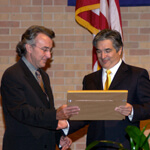
Julio C. Palmaz, M.D., who revolutionized cardiology and peripheral vascular medicine by inventing the world’s first stent, was named an Ashbel Smith Professor Jan. 19 at the Health Science Center. The professorship is named for Ashbel Smith, M.D., pioneering Texas physician who was the first chairman of The University of Texas Board of Regents (1881-1886).
“The Palmaz Stent is rightfully included today whenever the world’s greatest medical inventions are chronicled,” said Francisco G. Cigarroa, M.D., president of the Health Science Center. “It is most fitting that we appoint this great physician-scientist to the Ashbel Smith Professorship, which remembers another Texas physician and pioneer of important distinction.”
Dr. Palmaz is a longtime professor in the department of radiology at the Health Science Center. Stewart R. Reuter, M.D., J.D., who as chairman of radiology provided essential support in the 1980s and ’90s as Dr. Palmaz developed the stent, said its impact “on reducing the cost and morbidity of the treatment of coronary artery disease has truly been of Nobel Prize dimensions. Today, most coronary angioplasties are followed by stent placement. All of us have at least one friend who has had a stent.”
David E. Allie, M.D., chief of cardiothoracic and endovascular surgery at the Cardiovascular Institute of the South in Lafayette, La., said Dr. Palmaz’s work “is changing the face of surgical care, and his achievements as a scientist, educator and inventor have been an inspiration to me personally to pursue a nontraditional endovascular career pathway to treat cardiovascular disease. His achievements have and will significantly influence the careers of generations of physicians in the future.”
Gerald D. Dodd III, M.D., current chairman of radiology at the Health Science Center, said “Dr. Palmaz has had a spectacular academic career excelling in both research and education. The stent has had a major impact on the management of atherosclerotic arterial disease, and in particular, it has revolutionized the management of coronary artery disease.”
The U.S. Food and Drug Administration (FDA) approved the stent for use in peripheral vascular arteries in 1990 and for use in coronary arteries in 1994. Today, an estimated 2 million people undergo coronary artery stenting annually. The stent is a tiny wire-mesh, spring-loaded tube threaded through a blood vessel with a balloon catheter (the procedure is called angioplasty). After balloon deflation and removal, the stent remains as a permanent scaffold to keep the vessel open.
“Dr. Palmaz’s development of the stent is one of the best and most significant examples of ‘bench to bedside’ translational research in medicine,” Dr. Dodd said. “The stent began as a concept that led to the development of a crude prototype, a series of animal studies were performed to test the application, the device was refined, FDA clearance was received, pilot studies in humans were performed, and finally, numerous large clinical trials proved its efficacy.”
Dr. Reuter said he has been fortunate to be associated with Dr. Palmaz since the start of Dr. Palmaz’s radiological career. “I have been able to witness firsthand the single-minded determination with which he pursued the development of the stent, from the first idea for a mechanical means to inhibit restenosis (a repeat closing of an artery after balloon angioplasty), through the development of one of the top vascular laboratories in the country, through the FDA approval process, to the ultimate approval and success of the stent,” Dr. Reuter said.
The surprise announcement came during the annual Presidential Awards Ceremony, where Dr. Cigarroa honored more than a dozen faculty and staff. Sunil K. Ahuja, M.D., M.Sc., noted HIV-AIDS genetics researcher and professor of medicine, microbiology and immunology, received this year’s highest honor, the 2006 Presidential Distinguished Scholar Award.
Ashbel Smith Professors at the Health Science Center have included Robert Leon, M.D., former chairman of psychiatry; Suellen Reed, Ph.D., former associate dean of the graduate program in the School of Nursing; and Kenneth Rudd, D.D.S., professor emeritus of prosthodontics and former associate dean of continuing dental education. The late Joseph Seitchik, M.D., professor of obstetrics and gynecology, was the institution’s first Ashbel Smith Professor.

